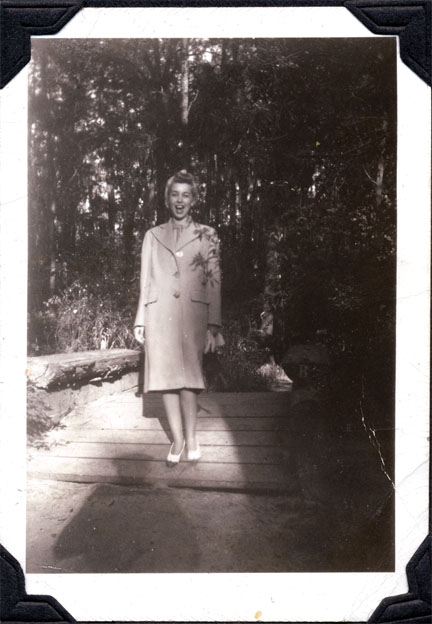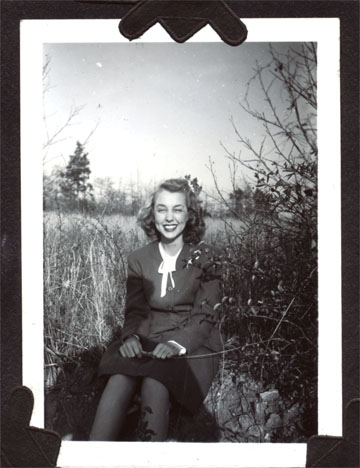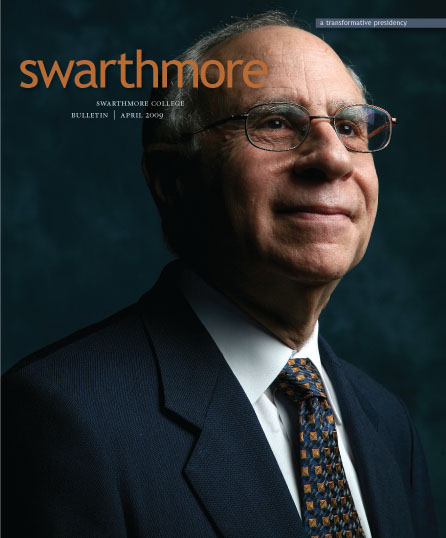The Age-old Art of Storytelling Goes Digital

"I loved this workshop," says Nathalie Anderson. "I hope many more folks from the faculty and staff will take advantage of it, because these glimpses into people's lives and hearts are so very intriguing, so very moving."
Recently, Professor of English Literature Nathalie Anderson shared a piece of very personal information via a poem she wrote and an old photo album that belonged to her mother. One photo shows Anderson’s mother and the shadow of the man she was going out with during World War II—a pilot stationed in the Pacific, “before she met my father,” Anderson says. The poem focuses on the man’s shadow.
“ … his shape an arrow arrowing, a missile fixed, so phallic / you’d laugh too: her shoulder with leafy shade corsaged; / the edge of the bridge darkening his dark, a scarfing; / her coat swayed at the hem from the thought of the thrust of him,” Anderson writes.
Together, poem and photos tell a story, each enlivening the other. Using software and a microphone, Anderson captured her story digitally for viewing on the Internet—as a participant in a digital storytelling workshop, the third on campus facilitated by Chief Information Technology Officer Gayle Barton.
After listening to a conference speaker talk about digital storytelling workshops in 2001, Barton—at the time still director of institutional technology at Williams College—says, “I was so taken by what he was saying and what he was doing—I really did feel a bit as if I’d drunk the Kool-Aid.”
Barton invited Joe Lambert, who founded the Center for Digital Storytelling (CDS) in Berkeley, Calif., in 1994, to hold a three-day workshop at Williams College, during which participants compiled an original script based on a personal experience, then recorded the script to produce the voice-over for a video created with photos or other fitting images.
The success of the Williams workshop encouraged Barton, who came to Swarthmore in 2007, to initiate a similar event at the College last June. Since then, two further workshops have taken place, with a total attendance of 29, comprising 14 faculty and 16 staff, one of whom attended twice. At the end of the workshop, participants shared their final products and celebrated each others’ stories.
The workshops began with a group session during which all participants discussed their story ideas and brainstormed ways to present them.
 Web Multimedia Specialist Nathan Stazewski said: “I was a little hesitant about the whole storytelling aspect, being much more interested in learning tips and tricks for Final Cut, the video editing software we used in the workshop and which I recently started using to edit videos for my job. The group was really helpful in pulling out the most interesting parts of a story. My original piece was a little long, but the facilitators were wonderful in showing me how to determine the true meat of the story. I’ve found the process to be very helpful as I create videos for my job.”
Web Multimedia Specialist Nathan Stazewski said: “I was a little hesitant about the whole storytelling aspect, being much more interested in learning tips and tricks for Final Cut, the video editing software we used in the workshop and which I recently started using to edit videos for my job. The group was really helpful in pulling out the most interesting parts of a story. My original piece was a little long, but the facilitators were wonderful in showing me how to determine the true meat of the story. I’ve found the process to be very helpful as I create videos for my job.”
Some academic departments now use digital storytelling as a teaching tool. Associate Professor of French Carina Yervasi and lecturer in Spanish Joan Friedman have both had students compile digital stories.
As well as enhancing the opportunities for creative academic learning, Barton believes that digital storytelling technology can also help people become more comfortable using technology and encourage them to think about different forms of communication.
“What makes it really exciting for me, though,” says Barton, “is that I see it as a tremendous community builder. You can sit in a room with eight or 10 people, whom you may have met but don’t know well, and you go through this workshop together and learn something about each other, some story they have that’s important enough for them to want to spend three days on it—and you get to know them.”
—Carol Brévart-Demm
 Email This Page
Email This Page